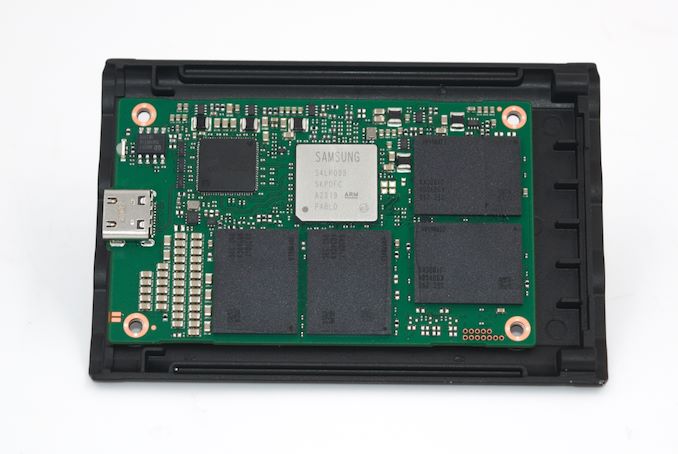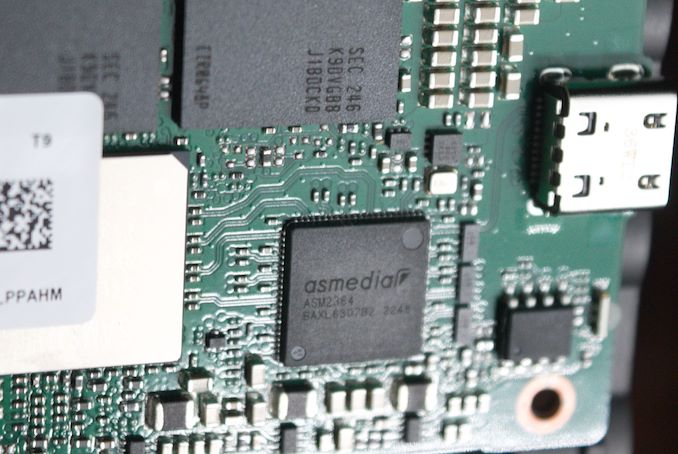
Samsung’s portable SSD lineup has enjoyed significant market success since the launch of the T1 back in 2015. Despite the release of the Thunderbolt-capable X5 PSSD in 2018, the company has been focusing primarily on the mainstream market with its T series drives.
The first set of PSSDs from Samsung incorporated a SATA SSD behind a USB 3.2 Gen 1 bridge chip. With the T5 in 2017, the company moved to a USB 3.2 Gen 2 bridge while retaining the SATA SSD. In the T7 Touch launched in 2020, the SATA component was replaced by a NVMe SSD and the USB 3.2 Gen 2 SATA bridge was replaced by a NVMe one. The T7 series was augmented with IP65-rated models (the T7 Shield) in 2022. Despite the same T7 moniker, the Shield’s use of newer NAND enabled improvements in both latency and power consumption.
Samsung is introducing the 2 GBps-class Portable SSD T9 today. Equipped with a USB 3.2 Gen 2×2 (20 Gbps) interface, the PSSD advertises double the performance of the T7 Shield. The company sent over the highest capacity version (4 TB) to put through our rigorous evaluation routine for direct-attached storage devices. The review below presents an in-depth investigation into the design and performance profile of the Samsung Portable SSD T9.
Introduction and Product Impressions
External bus-powered storage devices have grown both in storage capacity as well as speeds over the last decade. Thanks to rapid advancements in flash technology (including the advent of 3D NAND and NVMe) as well as faster host interfaces (such as Thunderbolt and USB 3.x / USB4), we now have palm-sized flash-based storage devices capable of delivering 3GBps+ speeds. While those speeds can be achieved with Thunderbolt, mass-market devices have to rely on USB. Within the USB ecosystem, USB 3.2 Gen 2 (10 Gbps) is fast becoming the entry level for thumb drives and portable SSDs. USB 3.2 Gen 2×2 (20 Gbps) got off to a slow start, but recent computing platforms from both Intel and AMD have started to support it on the host side. The introduction of native USB 3.2 Gen 2×2 flash controllers such as the Phison U18 and Silicon Motion SM2320 has enabled PSSD vendors to bring low-cost power-efficient 20 Gbps external drives to the market.
Broadly speaking, there are five distinct performance levels in this market:
- 2GBps+ drives with Thunderbolt 3 or USB4, using NVMe SSDs
- 2GBps drives with USB 3.2 Gen 2×2, using NVMe SSDs or direct USB flash drive (UFD) controllers
- 1GBps drives with USB 3.2 Gen 2, using NVMe SSDs or direct UFD controllers
- 500MBps drives with USB 3.2 Gen 1 (or, Gen 2, in some cases), using SATA SSDs
- Sub-400MBps drives with USB 3.2 Gen 1, using UFD controllers
Within each of these levels, there is further segmentation into entry-level, mid-range, and premium based on the choice of internal components. The Samsung Portable SSD T9 4 TB we are looking at today belongs to the second category in the above list. The T9 package comes with the main unit, an installation guide, and two 45 cm USB cables. The Type-C to Type-C one supports 20 Gbps speeds, while the Type-C to Type-A is restricted to 10 Gbps speeds. The main unit has a LED indicator and a Type-C female port (USB 3.2 Gen 2×2 is supported only with Type-C ports).
The main unit has a rubber sleeve, providing it with a bit of ruggedness (withstanding drops, etc.). However, the T9 does not have an IP rating. Disassembling the unit is fairly trivial – after removal of the sleeve, we can see four screws holding the two aluminum blocks together. Other than these, there are four screws hidden behind the label on either end as shown in the gallery below. The PSSD’s main board is sandwiched between the two blocks.
This design is slightly different from the earlier T series drives. We see a more thorough thermal solution with plenty of thermal pads spread out across the board. The aluminum blocks also have raised profiles on the inside in order to ensure good contact with the heat generating components of the board.
The board itself is very similar to the T7 Shield we reviewed earlier this year. The NVMe SSD controller is the same Pablo silicon, and the NAND package markings point to the use of the same 128L / 136T 6th Gen. V-NAND. The NVMe segment is DRAM-less. Compared to the 4 TB T7 Shield’s board, the only change is the replacement of the ASMedia ASM2362 by the ASMedia ASM2364 USB 3.2 Gen 2×2 – PCIe 3.0 x4 NVMe bridge chip.
This review compares the Samsung T9 against a host of other USB 3.2 Gen 2×2 PSSDs reviewed earlier. A quick overview of the internal capabilities of theese PSSDs is given by CrystalDiskInfo. The Samsung PSSD T9 supports full S.M.A.R.T passthrough, along with TRIM to ensure consistent performance for the drive over its lifetime.
| S.M.A.R.T Passthrough – CrystalDiskInfo | |
 |
 |
The table below presents a comparative view of the specifications of the different PSSDs presented in this review.
| Comparative Direct-Attached Storage Devices Configuration | ||
| Aspect | ||
| Downstream Port | 1x PCIe 3.0 x4 | 1x PCIe 3.0 x4 (M.2 NVMe) |
| Upstream Port | USB 3.2 Gen 2×2 Type-C (Female) | USB 3.2 Gen 2×2 Type-C |
| Bridge Chip | ASMedia ASM2364 | ASMedia ASM2364 |
| Power | Bus Powered | Bus Powered |
| Use Case | 2GBps-class, sturdy palm-sized high-performance portable SSD with a Type-C interface | Premium 2GBps-class, compact, and sturdy portable SSD in a gumstick form-factor targeting the gaming market |
| Physical Dimensions | 88 mm x 60 mm x 14 mm | 118 mm x 62 mm x 14 mm |
| Weight | 122 grams | 115 grams (without cable) |
| Cable | 45 cm USB 3.2 Gen 2×2 Type-C (male) to Type-C (male) 45 cm USB 3.2 Gen 2 Type-C (male) to Type-A (male) |
30 cm USB 3.2 Gen 2×2 Type-C to Type-C 30 cm USB 3.2 Gen 2 Type-C to Type-A |
| S.M.A.R.T Passthrough | Yes | Yes |
| UASP Support | Yes | Yes |
| TRIM Passthrough | Yes | Yes |
| Hardware Encryption | Yes | Not Available |
| Evaluated Storage | Samsung 136L V-NAND (6th Gen.) | Western Digital SN750E PCIe 3.0 x4 M.2 2280 NVMe SSD SanDisk / Toshiba BiCS 4 96L 3D TLC |
| Price | $440 | USD 210 |
| Review Link | Samsung T9 Portable SSD 4TB Review | WD_BLACK P50 Game Drive SSD 1TB Review #1 (2020) WD_BLACK P50 Game Drive SSD 1TB Review #2 (2021) |
Prior to looking at the benchmark numbers, power consumption, and thermal solution effectiveness, a description of the testbed setup and evaluation methodology is provided.
Testbed Setup and Evaluation Methodology
Direct-attached storage devices (including portable SSDs) are evaluated using the Quartz Canyon NUC (essentially, the Xeon / ECC version of the Ghost Canyon NUC) configured with 2x 16GB DDR4-2667 ECC SODIMMs and a PCIe 3.0 x4 NVMe SSD – the IM2P33E8 1TB from ADATA.
The most attractive aspect of the Quartz Canyon NUC is the presence of two PCIe slots (electrically, x16 and x4) for add-in cards. In the absence of a discrete GPU – for which there is no need in a DAS testbed – both slots are available. In fact, we also added a spare SanDisk Extreme PRO M.2 NVMe SSD to the CPU direct-attached M.2 22110 slot in the baseboard in order to avoid DMI bottlenecks when evaluating Thunderbolt 3 devices. This still allows for two add-in cards operating at x8 (x16 electrical) and x4 (x4 electrical). Since the Quartz Canyon NUC doesn’t have a native USB 3.2 Gen 2×2 port, Silverstone’s SST-ECU06 add-in card was installed in the x4 slot. All non-Thunderbolt devices are tested using the Type-C port enabled by the SST-ECU06.
The specifications of the testbed are summarized in the table below:
| The 2021 AnandTech DAS Testbed Configuration | |
| System | Intel Quartz Canyon NUC9vXQNX |
| CPU | Intel Xeon E-2286M |
| Memory | ADATA Industrial AD4B3200716G22 32 GB (2x 16GB) DDR4-3200 ECC @ 22-22-22-52 |
| OS Drive | ADATA Industrial IM2P33E8 NVMe 1TB |
| Secondary Drive | SanDisk Extreme PRO M.2 NVMe 3D SSD 1TB |
| Add-on Card | SilverStone Tek SST-ECU06 USB 3.2 Gen 2×2 Type-C Host |
| OS | Windows 10 Enterprise x64 (21H1) |
| Thanks to ADATA, Intel, and SilverStone Tek for the build components | |
The testbed hardware is only one segment of the evaluation. Over the last few years, the typical direct-attached storage workloads for memory cards have also evolved. High bit-rate 4K videos at 60fps have become quite common, and 8K videos are starting to make an appearance. Game install sizes have also grown steadily even in portable game consoles, thanks to high resolution textures and artwork. Keeping these in mind, our evaluation scheme for direct-attached storage devices involves multiple workloads which are described in detail in the corresponding sections.
- Synthetic workloads using CrystalDiskMark and ATTO
- Real-world access traces using PCMark 10’s storage benchmark
- Custom robocopy workloads reflective of typical DAS usage
- Sequential write stress test
In the next section, we have an overview of the performance of the Samsung Portable SSD T9 in these benchmarks. Prior to providing concluding remarks, we have some observations on the PSSD’s power consumption numbers and thermal solution also.










